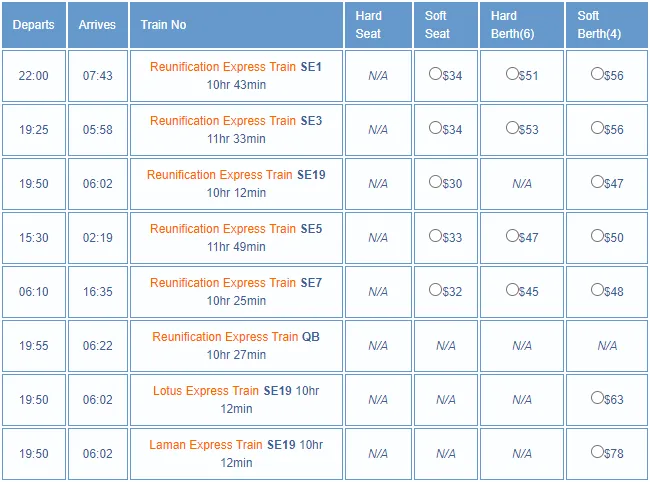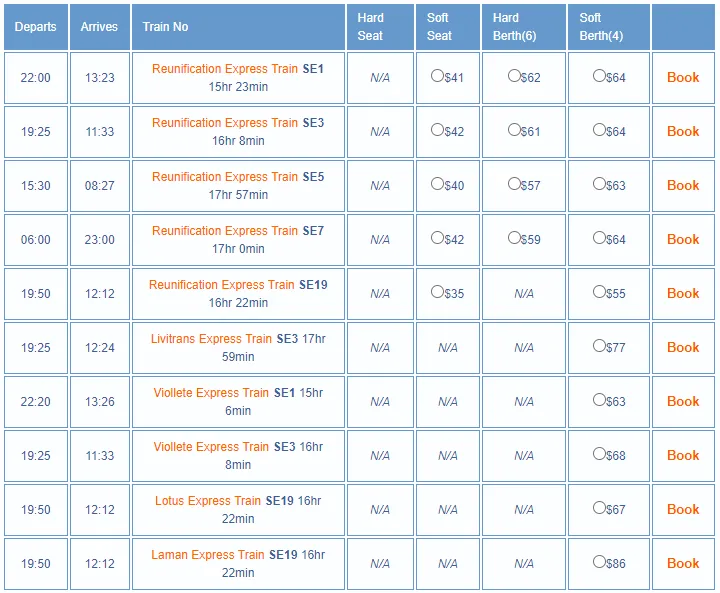Vietnam Railways is one of the oldest industries in Vietnam, established in 1881, and developing gradually over the years. Today, to travel to Vietnam by train, visitors can choose Vietnam sleeper trains for long distances. This will be a unique way to discover the beauty of Vietnam as you can cross both majestic passes and bustling cities. Overnight trains in Vietnam will be different from Western trains, so it's worth looking forward to this adventurous journey. The following guide to Vietnam overnight trains will help you visualise and better prepare for your trip.
1. General about Vietnam Sleeper train
Vietnam sleeper trains run overnight and offer a comfortable mode of transport as well as accommodation for tourists. With this type of travel, passengers save time and even money because of combining transportation and lodging expenses. However, the minus point is that you expect engine noise, shaking and a little bit of unhygienic toilets. Please consider this type of transfer carefully before attempting it.
There are several types of sleeper trains in Vietnam, ranging from basic to luxury options. The basic sleeper trains have shared cabins with bunk beds, while the more luxurious options may have private cabins and shower services.
Most trains offer a choice of soft or hard sleeper accommodations. Soft sleepers are more comfortable and offer more privacy, while hard sleepers are more affordable but offer less comfort and privacy.
Trains in Vietnam are operated by the state-owned Vietnam Railways company, and routes connect major cities and tourist destinations throughout the country. Some of the most popular routes include the Hanoi to Sapa route, which takes about 8 hours, and the Hanoi to Ho Chi Minh City route, which takes about 30 hours.

There are 3 main ticket type for you to choose from:
- Ticket type: 6 berths per cabin
- Ticket type: 4 berths per cabin
- Ticket type: 2 berths per cabin
The ticket price is varied based on the route, however, the ticket price for children is calculated as:
- Under 2 years: Travel free
- From 2 to under 9 years old (and being shorter than 1,3m): Price is 75% of the adult price for the North-South ticket and vice versa. But for tickets from Hanoi - Sapa and vice versa, the children will be fully charged as the adults.
- Over 9 years old: fully charged as adults
Carry-on luggage: 20kg for adults and 10kg for children
2. Type of cabin
2-berth cabin
This is the most VIP cabin with generous space for couples who would like to have a private time. Each bed is often 80x190cm in size. Normally, the ticket price for this cabin is double the 4-berth cabin, with many complimentary snacks, beer, soft drink, wet towels, hairbrushes, toothbrushes, toothpaste…

4-berth cabin
A 4-berth cabin usually has 4 beds, divided into 2 floors. Each bed is the same size as the 2-berth cabin (80x190cm). This is considered the spacious and VIP cabin of the train.
Staying in this cabin, you will have full amenities with air conditioning, soft blankets, luggage storage, safety door latch, charging sockets and free mineral water to use. This is more convenient compared to 6-berth cabins and travellers are advised to try to enjoy the wonderful scenery through the window.

6-berth cabin
The 6 berths of this cabin are covered with a mattress of about 3cm thin. In the cabin, there will be 6 beds divided into 3 floors, with the size of each bed is about 78x190cm. The only drawback of this 6-berth cabin is that the 1st floor is relatively stable and the passengers staying on the 2nd and 3rd floors will feel uncomfortable because the space is a bit short and uncomfortable when sitting up straight.

3. Should we Choose a Lower or Upper Berth?
Before booking a train ticket, you may hesitate a bit between lower berth and upper berth. The decision of choosing a lower or upper berth on a sleeper train in Vietnam is up to personal preference and the specific needs of each individual. The lower berth offers more space and is generally more comfortable than the upper berth, especially for taller passengers who may find the upper berth cramped. If you have a lot of luggage or prefer easy access to your belongings, the lower berth may be more convenient for you. However, if you prefer more privacy and don't mind climbing up and down a ladder, the upper berth may be a better choice. The lower berth can be noisier due to passengers walking by and talking, while the upper berth is generally quieter and more peaceful.

Lower berth and upper berth on Chapa Express Train
4. Food on Vietnamese Trains
Food is often available for purchase on Vietnamese trains, although the options and quality can vary depending on the train and the route. Train attendants may come around selling snacks and drinks, such as instant noodles, packaged cookies, and bottled water. The menus are often limited and may feature simple Vietnamese dishes such as rice, noodle soups, sausages and stir-fries.

If you're travelling on one of the more luxurious trains, such as Sapaly or Livitrans, you will have the option of ordering more elaborate meals from a restaurant. Of course, these trains tend to be pricier than the standard options.

If you have dietary restrictions or preferences, bringing your own food on the train may be a good idea, especially if you're not sure what options will be available.
5. Safety on night trains in Vietnam
While road traffic is unsurprisingly a little bit crazy, taking a train is the safest way to travel around the country. Selecting a sleeper train is a much better alternative option for a sleeper bus.
What you need to be concerned about is onboard thieves. However, as with any type of travel, there are always risks to be aware of and precautions to take. It's best to book your ticket well in advance if you travel in a group to ensure you have a reserved berth. This reduces the risk of having to share a cabin with strangers. Keep your valuables with you at all times and lock the cabin well before falling into sleep.

>> Hanoi's Train Street: A Heart-Stopping Adventure Through Local Life
It is important to secure your belongings when travelling on a Vietnam train because theft and pickpocketing can be a common occurrence on trains in Vietnam. Thieves may target travellers, particularly those who appear to be tourists and steal their valuables, including money, cameras, and electronic devices. To avoid becoming a victim of theft, you should take precautions such as keeping your valuables close to you and out of sight, using locks on your bags and luggage, and avoiding displaying large amounts of cash or expensive jewellery. Additionally, it's important to be aware of your surroundings and avoid leaving your belongings unattended, particularly in crowded areas like train stations or on the train itself.
6. Sleeper train routes worth combining in your journey
Taking an overnight train on your Vietnam trip can be a great way to experience Vietnam's beautiful countryside and save time on travel by combining transportation and accommodation in one. Before you embark on your train ride, do some research on the route and the scenery you'll encounter along the way. This way, you can plan ahead and know when to look out for the best views.

6.1. Hanoi - Lao Cai
To reach Sapa from Hanoi, you can take a train to Lao Cai station, which is about 288km away. From Lao Cai, you can easily get to Sapa by car, bus or taxi, which takes around 50 minutes.
There are two types of sleeper trains available: normal Vietnamese railways and privately run sleeper trains for tourists. The most popular trains with tourists are SP1, SP2, SP3, and SP4 operated by the following reputable train brands: Sapaly Express Train, Orient Express Train, Livitrans Express Train, The Pumpkin Express Train, Fansipan Express Train, King Express Train, Chapa Express Train, Laman Express Train, and Victoria Express Train. The normal trains have soft sleeper cabins with air conditioning and four berths.

Table: The most popular trains Hanoi - Sapa and vice versa
6.2. Hanoi - Dong Hoi
You can take a train from Hanoi to Dong Hoi and choose to book a sleeper berth to make your journey more authentic.
Soft sleeper berths are more comfortable and spacious than hard sleeper berths, with four beds in each cabin. They come with pillows, blankets, and bed sheets, as well as individual reading lights and power sockets. Hard sleeper berths have six beds in each cabin and are less comfortable than soft sleeper berths. The higher-class accommodations tend to be more comfortable but also more expensive.
The train journey takes approximately 10-12 hours, depending on the specific train and the number of stops along the way.

Table: Popular trains from Hanoi to Dong Hoi
>> Click here to book directly at the Vietnam Railways website
6.3. Hanoi - Hue
There are several options for sleeper trains from Hanoi to Hue. This train has a variety of classes, including soft seats, hard sleepers, and soft sleepers. Soft sleeper cabins have four beds and are the most comfortable option, while hard sleeper cabins have six beds and are more budget-friendly. The journey takes approximately 13-14 hours.

Table: Popular trains from Hanoi to Hue
>> Click here to book directly at the Vietnam Railways website
6.4. Hanoi - Danang
There are several trains that run between Hanoi and Da Nang, including the SE2, SE4, SE6, SE8, TN2, and TN4. These trains operate daily, depart from Hanoi's main train station, Hanoi Railway Station, and arrive at Da Nang Railway Station.
The journey takes approximately 14-16 hours, depending on the train you choose and the specific route it takes.

Table: Popular trains from Hanoi to Danang
>> Click here to book directly at the Vietnam Railways website
6.5. Ho Chi Minh - Nha Trang
The journey by train from Ho Chi Minh City to Nha Trang takes approximately 8-9 hours.

Table: Popular trains from Ho Chi Minh - Nha Trang
>> Click here to book directly at the Vietnam Railways website
7. Tips to travel by Vietnam sleeper train
- Dress comfortably so that if you are on the upper floor, you can easily move up and down.
- Bring some snacks, tissues, hand sanitiser.
- Keep the things you use often in a convenient bag so you can take it out anytime without having to drag all your stuff out.
- You should have a few things to entertain to make the train ride less boring. Like a board game deck or a fully charged phone.
- The air conditioner can be colder than usual so make sure you bring some warm clothes, you will need to use them at some point.
- Book your train ticket in advance to ensure availability, especially during the peak season and holidays.
>> Easy Sapa Tour from Hanoi by Train & Shuttle Bus - 03 Days
>> Discover North & Central Vietnam by train - 10 Days
>> From Hanoi to Saigon: Vietnam Journey by Train - 15 Days
See more:





















 TRAVELERS' CHOICE 2025
TRAVELERS' CHOICE 2025 



19 Comments
France
Vietnam
Burkina Faso
Could you please advise the itinerary that includes experiencing the sleeper train? I really love to try once.
Vietnam
British Indian Ocean Territory
Vietnam
Australia
Vietnam
Hi Galina, Please follow this link to book your train ticket: vietnam-railway.com. If you need further assistance with the package tour, including the train journey, feel free to send your inquiry to [email protected].
Greenland
Vietnam
Hello Jamesop, please let us know your requirements for better support. Thank you!
Best regards, Tracy
New Zealand
Vietnam
Netherlands
I went from Da Nang to Hue on a train specifically for the view of the Hai Van Pass, and I had booked a soft sleeper cabin. The journey was long enough, in my experience. The toilets were clean and the train itself was acceptable, but we had our cabin (for two) all to ourselves.
The view was great for the first hour. After that, it's just more of the same, depending on the train and the area you're going through. Sometimes, it's so slow that you might as well just walk.
Australia
Vietnam
Hi Sherryn, please follow this link to book your train ticket vietnam-railway.com. In case you need more assistance about the package tour, feel free to send us your inquiry to [email protected]. Best regards,
India
Vietnam
Ireland
Vietnam
Hi Bernadette, you can book directly with Vietnam Railways via this official link: http://vietnam-railway.com. In case you want to book a tour package, please follow: https://izitour.com
Write Reply